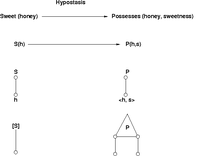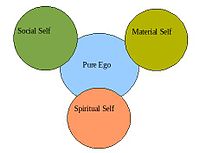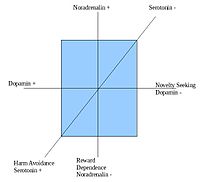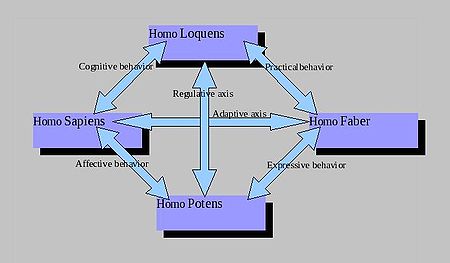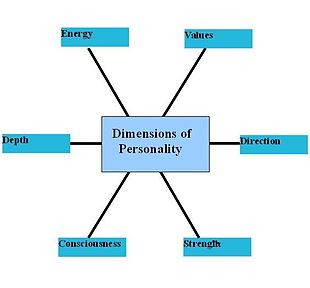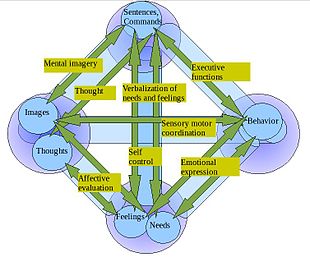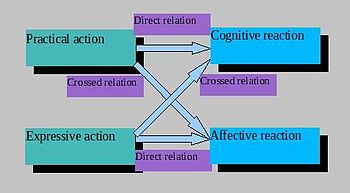- Hypostatic model of personality
-
Hypostatic model of personality 
Concepts
Personality aspect (hypostasis)
Personality dimension
Personality axis
Intrapersonal relation
Interpersonal relationOriginators
Charles Sanders Peirce
William James
Aaron Rosanoff
Louis Guttman
C. Robert Cloninger
Proponents
Codrin Stefan Tapu
Developers
Tessie J. RodriguezRelevant works
Hypostatic Personality[1]Psychology portal The hypostatic model of personality is a contribution to the psychology of personality, summarized by Codrin Stefan Tapu in 2001.[1] It argues that the person presents herself in different aspects or hypostases, depending on the internal and external realities she relates to, including different epistemological approaches to the study of personality. Alternative terms here are "dimensional model", "aspect theory", and "healthy multiplicity". The model falls into the category of complex, biopsychosocial approaches to personality.
The history of the concept can be traced back to Peirce's hypostatic abstraction, or personification of traits. Different authors have described various dimensions of the self (or selves), personality dimensions and subpersonalities. Contemporary studies link independent aspects of personality to specific biological, social, or environmental factors.
The hypostatic model describes personality aspects and dimensions, as well as intra- and interpersonal relations. Personality is viewed as both an agency and a construction, as the model is accompanied by specific methods of assessment and psychotherapy, addressing each of the personality dimensions.
As a constructivist approach, it points to errors in empiricist assumptions, and exposes itself to criticisms of "lack of objectivity".
Contents
Historical background
Origins and terminology
Charles Sanders Peirce introduced the concept of hypostatic abstraction, which is a formal operation that takes an element of information, such as might be expressed in a proposition of the form "X is Y", and conceives its information to consist in the relation between a subject and another subject, such as expressed in a proposition of the form "X has Y-ness".[2]
In linguistics, Leonard Bloomfield introduced the concept of hypostasis[3] to describe the personification of an object or state in sentences as I'm tired of your buts and ifs.
Aaron Rosanoff's theory of personality distinguishes seven dimensions (Normal, Hysteroid, Manic, Depressive, Autistic, Paranoid, and Epileptoid), which can be epistatic or hypostatic dimensions, the manifestation of the latter being concealed or inhibited by the former.[4]
Variants and evolution: selves and dimensions
In the philosophy of mind, double-aspect theory is the view that the mental and the physical are two aspects of the same substance.[5]
In his Principles of Psychology,[6] William James describes four aspects of the self:
- material self (the body and the person's closest possessions and relatives, including the family);
- social self (the being-for-others);
- spiritual self (the person's inner and subjective being, her psychic faculties and dispositions, taken concretely);
- the "pure" ego (the bare principle of personal unity).
Using the same paradigm, cognitive psychologist Ulric Neisser describes five "selves":[7]
- ecological self, as directly perceived with respect to the immediate physical environment;
- interpersonal self, also directly perceived, established by specific emotional communication;
- extended self, based on memory and anticipation;
- private self (our private conscious experiences);
- conceptual self, a system of socially-based assumptions and theories about human nature in general and ourselves in particular.
Facet Theory asserts that social-behavioral concepts are multivariate, and therefore they could be better described in terms of their "facets" and dimensions rather than as undifferentiated wholes;[8] this can also be done using multidimensional scaling.[9] Hans Eysenck's three factor model of personality contains the independent dimensions of extraversion, neuroticism, and psychoticism; these different dimensions are caused by the properties of the brain, which themselves are the result of genetic factors.[10] The Big Five model describes five personality dimensions that affect the whole behavior, with each dimension having several facets.[11] The Diagnostic and Statistical Manual of Mental Disorders uses a multiaxial system of diagnosis, taking into account five dimensions: mental state, global personality, physical condition, environment, and global functioning of the person.[12]
Towards a contemporary integration
Differentiation between various mental states and behavior patterns on the basis of their relation with brain and social environment became commonplace in contemporary psychology and sociology.[13][14][15]
On the biopsychological side, functional MRI studies have shown that different behavioral and mental activities involve specific patterns of brain activation, corresponding to psychological states.[16] C. Robert Cloninger defines three independent dimensions of personality, which are related to heritable variation in patterns of response to specific types of environmental stimuli; variation in each dimension is strongly correlated with activity in a specific central monoaminergic pathway:[17]
- novelty seeking, with frequent exploratory activity and intense excitement in response to novel stimuli, and with low basal dopaminergic activity;
- harm avoidance, with intense responses to aversive stimuli and a tendency to learn to avoid punishment, novelty, and non-reward passively, and with high serotonergic activity;
- reward dependence, with intense responses to reward and succorance and a tendency to learn to maintain rewarded behavior, and with low basal noradrenergic activity. These neurobiological dimensions interact to give rise to integrated patterns of differential responses to punishment, reward, and novelty.
On the social-environmental side, role theory[18] defines the role as a set of connected behaviors, rights and obligations as conceptualized by actors in a social situation. Thus, roles can be:
- cultural roles: roles given by culture (e.g. priest);
- social differentiation: e.g. teacher, taxi driver;
- situation-specific roles: e.g. eye witness;
- bio-sociological roles: e.g. as human in a natural system;
- gender roles: as a man, woman, mother, father, etc.
As a core idea of his transactional analysis, Eric Berne asserts that there are at least three "persons" in each of us, calling them our "ego states": the Child (the emotional in us), the Adult (the rational in us), and the Parent (the authoritarian in us).[19] As functioning as a “society of mind”,[20] the self is populated by a multiplicity of “self-positions” that have the possibility to entertain dialogical relationships with each other.[21] Internal Family Systems Model combines systems thinking with the view that mind is made up of relatively discrete subpersonalities each with its own viewpoint and qualities.[22]
Description
Organization of personality
Many schools of psychotherapy see subpersonalities as relatively enduring psychological structures or entities that influence how a person feels, perceives, behaves, and sees him- or herself.[23] According to the hypostatic model, human personality consists of four components or hypostases, which are patterns of traits pertaining to specific systems in the brain, and are conceptualized by virtually every culture as being characteristic and/or essential to humans:
- the basic cognitive component - "Homo Sapiens" (the intelligent and creative person), which is in connection with sensory areas of the cerebral cortex;
- the verbal subsystem - "Homo Loquens" (the speaking, communicating, and [self-]controlling person), which is connected with the activities of association areas;
- the motivational subsystem - "Homo Potens" (the powerful and energetic person), which is correlated with the activity of the limbic system;
- the pragmatic component - "Homo Faber" (the productive and industrious person), which is linked to motor cortex activity.[24][25]
Human behavior is generated through the interaction and coupling of these human aspects, creating personality dimensions.[26] The six behavioral, mental, and personality dimensions are:
- cognitive behavior, generated by Homo Sapiens and Homo Loquens[27] - the "consciousness" dimension;[28]
- practical behavior, produced by Homo Loquens and Homo Faber[27] - the "strength" dimension;[28]
- affective behavior, conducted by Homo Sapiens and Homo Potens[27] - the "values" dimension;[29]
- expressive behavior, "co-worked" by Homo Potens and Homo Faber[30] - the "energy" dimension;[31]
- personality regulation, provided by Homo Loquens and Homo Potens, which form the regulative axis of personality[27] - individual "direction";[31]
- general perceptual-motor adaptation, ranging from simple reactions to complex adaptive patterns, performed by Homo Sapiens together with Homo Faber, which form the adaptive axis of personality[27] - individual "depth".[29]
In every specific task, one of the first four dimensions (cognitive, practical, affective, or expressive) is dominant, being at the center of the experience, whereas the other three are subordinated to it. Regulative and adaptive dimensions are constantly acting as a background throughout the behavioral process.[32] The same model was extended to the familial-organizational and societal levels.[33]
Relations
According to the model, intrapersonal relations can be:[34][35]
- direct relations (cognitive decision followed by practical action: "I decided that's better for me to leave my boyfriend, and I told him that", or affective decision followed by expressive action: "I love my girlfriend, so I'm always gentle with her");
- crossed relations (cognitive decision followed by expressive action: "Today I decided that it's better for me to break up with my girlfriend, and I'll behave so that she will leave me", or affective decision followed by practical action: "We love each other; that's why we are moving in together").
Interpersonal relations can also be:[34][36]
- direct (cognitive reaction to another persons's practical action: "My girlfriend wants to make up with me, and I agree, because that's better for both of us", or affective reaction to the other's expressive action: "She loves me, I can feel it in her eyes");
- crossed (affective reaction to other's practical action: "My partner wants to buy me a house, and therefore I assume he/she loves me", or cognitive reaction to an expressive action of another person: "He is giving me a bitter look, and I'm wondering what is wrong?").
Personality as an agency and as a construction
In addition to this "doing" dimension of personality, there is also a "being made" dimension, including the constitutive axes - each one formed of a personality trait (which can be cognitive, verbal, motivational, or pragmatic, depending on the personality aspect), a mental and behavioral activity related to it (which can be cognitive, practical, affective, expressive, regulative, or adaptive), and their brain and environmental correlates, respectively.[37] Each constitutive axis consists of two couples: one formed by a brain factor and the corresponding behavior, shaping a psychological disposition or trait, and the other one formed by that psychological trait and its environmental correlate, generating the specific behavior.[37] For example, assertive behavior is determined by environmental factors and assertiveness, whereas assertiveness itself, as a trait, is the product of both brain predisposition and assertive behavior. This model provides a picture of the emergent relations between personality traits, behavior, environment, and biology.[38]
Methods
This theoretical model laid the foundation of a methodology of assessment and psychotherapy based on the same "couples of forces", consisting of:
- biological and ecological assessment through methods of dynamic analysis of development,[39] investigating the complex interplay of stimulating and inhibiting factors of development and their effects on developmental speed (acceleration or deceleration), with prognostic implications;
- cognitive and affective techniques (method of prints of consciousness,[40] based on self-coverage and self-report; human liberty test,[41] using free-choice activities in order to study probability in an individual's behavior);
- practical techniques (method of operational chains,[42] a form of mental chronometry);
- regulative techniques[43] (task boosting techniques);
- perceptual-motor adaptation techniques (test of adaptive reactivity;[44] method of adaptive therapy,[45] based on non-specific perceptual-motor learning);
- relational techniques, aimed at assessing and replacing crossed relations with direct relations.[46]
General evaluation of the approach
Being a constructivist approach, it maintains "the widespread, commonsensical, subject-centered, Aristotelian-empiricist epistemological paradigm", and, pointing to errors in empiricist assumptions, "it swings to a relativist epistemology without abandoning the paradigm itself". [47]
Karl Jaspers criticized the hypostatic method as used in the study of personality, arguing that:
Types, images, and theoretical systems are used by us purely as schemata of ideas to illuminate the path of our knowledge of particulars but they are not significant for knowledge in themselves. If now we objectify these schemata, images and theories and give them a being as if they were there as an object is there, then we 'hypostasise' an idea. This is the way in which ideas lose all their élan as a break-through movement of knowledge into the open and the knowledge we are left with is a sort of pseudo-knowledge which sooner or later will have to reveal itself as 'lacking in objectivity'.[48]
See also
- Personality systematics
- Cognitive-affective personality system
- Systems psychology
- Intrapersonal communication
- Constructivist epistemology
References
- ^ a b Tapu, Codrin Stefan (2001). Hypostatic Personality: Psychopathology of Doing and Being Made. Premier. ISBN 973-8030-59-5.
- ^ Peirce, Charles Sanders (1931). "The Simplest Mathematics". in Collected Papers, CP 3., Harvard University Press, p. 437. ISBN 0-674-13801-5.
- ^ Fought, John G. (1999). Leonard Bloomfield: Critical Assessments of Leading Linguists. Volume 1, Taylor & Francis, p. 307. ISBN 0-415-17447-3.
- ^ Bridges, J. W. (1923). "Theories of Temperament: An Attempt at Reconciliation". Psychological Review 30 (1): 36–44. doi:10.1037/h0070116. http://psycnet.apa.org/index.cfm?fa=buy.optionToBuy&id=1926-06624-001&CFID=6243058&CFTOKEN=12429211.
- ^ Stubenberg, Leopold (3 February 2005). "Neutral Monism and the Dual Aspect Theory". Stanford Encyclopedia of Philosophy. Metaphysics Research Lab, CSLI, Stanford University. http://plato.stanford.edu/entries/neutral-monism/#9.4. Retrieved 27 December 2009.
- ^ James, William (2001). Psychology: The Briefer Course. Dover, pp. 43-84. ISBN 0-486-41604-6.
- ^ Neisser, Ulric (1988). "Five Kinds of Self Knowledge". Philosophical Psychology 1 (1): 35–59. http://www.le.ac.uk/pc/nk70/neisser.pdf.
- ^ Guttman, Louis (1944). "A basis for scaling qualitative data". American Sociological Review 9 (2): 139–150. doi:10.2307/2086306. JSTOR 2086306.
- ^ Kruskal, J. B., and Wish, M. (1978). Multidimensional Scaling. Sage University Paper series on Quantitative Application in the Social Sciences, 07-011. Beverly Hills and London: Sage Publications.
- ^ Eysenck, Hans (1991). "Dimensions of personality: 16: 5 or 3? Criteria for a taxonomic paradigm". Personality and Individual Differences 12: 773–790. doi:10.1016/0191-8869(91)90144-Z.
- ^ Saulsman, L. M.; Page, A. C. (2004). "The five-factor model and personality disorder empirical literature: A meta-analytic review". Clinical Psychology Review 23 (8): 1055–1085. doi:10.1016/j.cpr.2002.09.001. PMID 14729423. http://www.sciencedirect.com/science?_ob=ArticleURL&_udi=B6VB8-4B5JM7X-1&_user=10&_rdoc=1&_fmt=&_orig=search&_sort=d&_docanchor=&view=c&_searchStrId=1033100218&_rerunOrigin=scholar.google&_acct=C000050221&_version=1&_urlVersion=0&_userid=10&md5=985cad7f67f962ce379755f055e60a11.
- ^ American Psychiatric Association (2000). Diagnostic and Statistical Manual of Mental Disorders, Fourth Edition, Text Revision (DSM-IV-TR). American Psychiatric Association, p. 27. ISBN 0-89042-025-4.
- ^ Rosenberg, Seymour (1997). "Multiplicity of selves". in Ashmore, Richard D., Jussim Lee J. (editors) Self and identity: fundamental issues. Volume 1 of Rutgers series on self and social identity, Oxford University Press US, p. 23. ISBN 0-19-509827-7.
- ^ Carter, Rita (2008). Multiplicity: The New Science of Personality, Identity, and the Self. Little Brown and Company. ISBN 0-316-11538-X.
- ^ Salgado, J; Hermans, HJM (2005). "The Return of Subjectivity: From a Multiplicity of Selves to the Dialogical Self". E-Journal of Applied Psychology: Clinical section 1 (1): 3–13. http://ojs.lib.swin.edu.au/index.php/ejap/article/viewFile/2/189.pdf.
- ^ Norman, KA; Polyn, SM; Detre, GJ; Haxby, JV (2006). "Beyond mind-reading: multi-voxel pattern analysis of fMRI data". TRENDS in Cognitive Sciences 30: 10. doi:10.1016/j.tics.2006.07.005. http://compmem.princeton.edu/NormanEtAlTICS.pdf.
- ^ Cloninger, CR. (1986). "A unified biosocial theory of personality and its role in the development of anxiety states". Psychiatric Developments 4 (3): 167–226. PMID 3809156.
- ^ Biddle, BJ (1986). "Recent Developments in Role Theory". Annual Review of Sociology 12 (1): 67–92. doi:10.1146/annurev.so.12.080186.000435. http://arjournals.annualreviews.org/doi/abs/10.1146%2Fannurev.so.12.080186.000435.
- ^ Berne, E. (1979). Transactional Analysis. Ballantine Books. ISBN 0-345-28474-7.
- ^ Minsky, M. (1985). The society of mind. Simon & Schuster. ISBN 0-671-60740-5.
- ^ Hermans, Hubert J.; Kempen, Harry J.; Van Loon, Rens J. (1992). "The dialogical self: Beyond individualism and rationalism". American Psychologist 47 (1): 23–33. http://huberthermans.com/102.pdf.
- ^ Schwartz, Richard C. (1997). Internal Family Systems Therapy. Guilford Press. ISBN 1-57230-272-0.
- ^ Fall, Kevin A., Miner Holden, Janice, Marquis, Andre (2004). Theoretical Models of Counseling and Psychotherapy. Brunner-Routledge, p. 444. ISBN 1-58391-068-9.
- ^ Tapu (2001), p. 16
- ^ Tapu (2001), p. 23
- ^ Rodriguez, Tessie J. (2009). Understanding Human Behavior. Rex Bookstore Inc., pp. 191-195. ISBN 971-23-5244-7.
- ^ a b c d e Tapu (2001), p. 18
- ^ a b Rodriguez (2009), p. 195
- ^ a b Rodriguez (2009), p. 194
- ^ Tapu (2001), p. 19
- ^ a b Rodriguez (2009), p. 193
- ^ Tapu (2001), pp. 17, 19
- ^ Tapu (2001), pp. 128-136
- ^ a b Tapu (2001), pp. 82-83, 100-101
- ^ Tapu, Codrin Stefan (2011). Guide to Relational Therapy. CAdPsy, pp. 5-6. ISBN 978-1466326699
- ^ Tapu (2011), pp. 7-8
- ^ a b Tapu (2001), pp. 28-29
- ^ Tapu (2001), pp. 21-31
- ^ Tapu (2001), p. 102
- ^ Tapu (2001), p. 89
- ^ Tapu (2001), p. 93
- ^ Tapu (2001), p. 87
- ^ Tapu (2001), p. 96
- ^ Tapu (2001), p. 91
- ^ Tapu (2001), p. 99
- ^ Tapu (2001), pp. 100-102
- ^ Matthews, M. R. (1992). "Old wine in new bottles: a problem with constructivist epistemology". Philosophy of Education Yearbook. http://www.ed.uiuc.edu/eps/PES-Yearbook/92_docs/Matthews.HTM.
- ^ Jaspers, Karl (1997). General Psychopathology. Volume Two, Johns Hopkins University Press, p. 652. ISBN 0-8018-5815-1.
External links
Personality theories Biospheric model of personality · Cognitive-affective personality system · Constructivism (psychological school) · Distressed personality type · Ego psychology · Hypostatic model of personality · Nature versus nurture · Personal construct theory · Personality Assessment System · Personality systematics · Personology · Phenomenal field theory · Positive Disintegration · Psychological behaviorism · Self monitoring · Situationism (psychology) · Trait theory · Two-factor models of personality
Categories:- Personality theories
Wikimedia Foundation. 2010.

